How Retailers Should Re-Think
Their Operations Practices and Methods
A Position Paper by
Valerie Bonebrake, Tompkins Associates
February 2009
Introduction
Faced with the economic downturn, changes in consumer demand and the effects of increasing supply chain complexity on their operations, retailers are reacting quickly to adjust to current conditions.
Reducing costs is critical, but doing so without regard to strategy stifles innovation and future growth. Assessing and managing global supply chain performance and efficiency are key to maintaining profitability. This position paper presents insights and examines tools and methodologies to help retailers re-think old strategies in order to effectively manage the challenges of global sourcing and the changing buying behaviors of consumers.
Retailing today is an evolving picture. It has become increasingly complex; global economic challenges, shifting consumer preferences, and more formidable competition are all changing the retail marketplaces. Sourcing experts must reach across the globe to design and source the most desirable products at the most economical unit prices. Now, practically overnight, it seems that a “new economy” is emerging – and it’s not a pretty one.
Credit markets have tightened, growth is slowing, and profits are shrinking. In response to current conditions, retailers operating in a world of even greater uncertainty must compete on total supply chain performance in order to survive and thrive. Yet, the challenge remains to have the right products, sourced from the right supplier globally, delivered on time to the right stores, in the right quantity, and at the lowest total delivered cost (TDC). This paper reviews these critical supply chain challenges, and it examines opportunities to re-think traditional practices and methods. Specifically, this paper:
-
Provides innovative ideas and fresh operations best practices for the new economy.
-
Presents new definitions of total Supply Chain Excellence, Total Delivered Cost, and other models that enable profitable market share growth.
-
Examines analytical-based methods and tools available that enable fact-based decision-making in sourcing, moving, and selling.
Challenges in Today’s World: a Macro View
In these challenging times, old rules and assumptions for sourcing and selling may no longer apply. Retailers are on a world-wide quest for lower costs, which is dramatically reconfiguring trade structures and relationships. As shown in Exhibit 1, there are many factors to manage, and risks increase in global supply chains.
Balancing all the variables in a global supply chain for maximum performance presents a host of challenges and opportunities. However, before modifying what’s worked in the past, we must understand what’s happening today. Savvy consumers demand quality products at bargain prices, and access to the internet creates a whole new dynamic in competition.
Initially, global sourcing was the answer to low cost. But as the cost of labor, regulatory compliance, customs and duties, transportation and security all rise, off-shore sourcing is losing some of its low cost appeal. On top of that, speed is everything as life cycles of all kinds of products, not just fashion, become increasingly shorter. Low-cost country sourcing and total landed cost no longer tell the whole story. Supply chain costs do not end at the port of entry. Performance must now be evaluated based on the total lowest delivered cost of the right products arriving at the right stores at the right times and in the right condition.
Inventory risks are a major challenge. Supply disruptions can negatively impact revenue; longer supply chains mean increases in working capital and increases in obsolescence. Inventory must be optimized to manage safety stocks, reduce stock-outs, and minimize over-stocks. This requires advanced planning and well-executed logistics strategies that are synchronized with sourcing strategies.
Impact of Global Sourcing on Supply Chains
|
Factor Domestic Supply Chains Global Supply Chains |
||
|
Cycle Time |
Short |
Long |
|
Total Landed Cost |
Clear |
Ambiguous |
|
Numbers of Parties Involved |
Few |
Many |
|
Inventory Risk |
Low |
High |
|
Regulatory Risk |
Moderate |
High |
|
Intellectual Property Risk |
Low |
High |
|
Overhead Costs |
Low to Moderate |
High |
|
Information Availability |
Moderate to High |
Low |
|
Processes |
Well Defined |
Less Defined |
|
Internal Company Expertise |
Moderate to High Expertise |
Moderate to Low |
|
Security and Risk |
Low to Moderate |
Moderate to High |
Exhibit 1. Source: Supply Chain Digest White Paper, Gene Tyndall and Dan Gilmore, 2005
Ineffective management of these challenges negatively impacts the benefits of global sourcing substantially. An unsynchronized supply chain puts at risk expected benefits of global sourcing, such as:
-
Savings on a per unit basis are not comprehensively measured if overall logistics and supply chain costs are not considered and accurately calculated.
-
Lower cost per unit, but disproportionate increases in inventory costs due to longer and uncertain lead times.
-
Increased expediting costs due to the need to meet distribution and delivery requirements.
-
Increased overheads, due to requirements of global sourcing operations and more knowledgeable staff.
-
Missed operating budgets due to variances between expected and actual landed /delivered costs.
Many companies today are dealing with these risks. Meeting these challenges requires the right people, knowledge, methods, processes, tools and metrics in place to make informed decisions and manage through these challenges. The goal is to manage the impacts on financial results.
According to data from the Supply Chain Consortium (Exhibit 2), many other supply chain network risks are not routinely considered, yet any one can affect supply chain performance. Retailers who seek Supply Chain Excellence will evaluate the potential impact of these risks and address them through identification of warning signals, real-time metrics, and contingency plans.
Supply Chain Network Risk Considerations
|
Disruptions |
Not Considered Considered |
Disruptions in Decisions Subjectively in Decisions |
|
Labor disruptions at plants or DCs |
44% |
56% |
|
Natural disasters at plants or DCs |
53% |
47% |
|
Mechanical or systems breakdowns (internal or external) |
59% |
41% |
|
Labor disruptions at ports or carriers |
59% |
41% |
|
Capacity shortages at carriers or ports |
61% |
39% |
|
Natural disasters impacting ports or carriers |
79% |
21% |
|
Political unrest or conflict in sourcing country |
86% |
14% |
|
Political unrest or conflict in destination country |
93% |
7% |
Exhibit 2. Source: Supply Chain Consortium
Defining Total Supply Chain Excellence
The effectiveness with which global commerce strategies are executed has a significant impact on profitability, working capital, revenue growth, and shareholder value. As a result, sourcing globally, while keeping inventories in check and out-of- stocks to a minimum, can no longer be managed in functional silos; rather, it requires new levels of communication, collaborative synchronization, and Supply Chain Excellence.
Supply Chain Excellence is the key to global competitiveness. The most successful supply chains seamlessly integrate key business processes from original suppliers through to end users/consumers that provide products, services, cash, and information. For retailers, the process begins with market-driven sourcing strategies for the items to be bought or made, and then supported by an efficient and dynamic network design, inventory policies, effective planning, and reliable logistics processes. It includes all the operational processes of source, produce, move, distribute, deliver, and customer service.
According to a survey conducted by the Aberdeen Group, large enterprises cite the top three challenges in their global supply chains:
-
Lack of critical supply chain process visibility: 79%
-
Uncoordinated multi-tier supply chain processes: 56%
-
Longer lead times and variability: 35%
Retailers have continued to work on these and other related operations issues, but performance gaps still exist. There remains significant opportunity to reduce cost and improve performance. Exhibit 3 below illustrates the six levels of Supply Chain Excellence. It begins with organizational elements managing to their self interests, and evolves to a fully ideal state of synthesis with speed. Most companies today are focused on visibility and collaboration; however, very few are approaching synthesis. To achieve world-class Supply Chain Excellence, all aspects of the organization must be aligned and functioning as a whole, with the inherent flexibility to rapidly adapt to changing conditions and with the speed needed to capitalize on market opportunities. Only a handful of companies today can truly claim this superior achievement.
Surveys indicate that four out of five CEOs cite revenue growth as a key priority, yet that is often coupled with the need to reduce costs in order to maintain profit margins. These are challenging tasks, especially in today’s environment. Demand can change on a whim, the supply chain can suddenly face interruptions or delays, and unexpected cost increases such as fuel volatility can wreak havoc on the operating budget. Today’s executives need to be aware of the opportunities that exist in the supply chain to improve performance if the organization is committed to Supply Chain Excellence.
The model (Exhibit 3) would suggest that a company should be at least at Level IV in order to have the collaboration needed to achieve performance that considers total delivered cost in its supply chain. For top quartile performing companies, emphasis is now shifting to look at total delivered cost vs. total landed cost when it comes to measuring supply chain performance. Landed costs are the costs to Port of Entry, whereas delivered costs reflect all costs to the retail store, or point of consumption. Both rising transportation costs and network designs that create extra touch points in the chain can drive up operating costs, and longer supply chains tie up more working capital.
Now is the right time for companies to look at the total costs of logistics in concert with low cost country sourcing in order to achieve the lowest total delivered cost. Departments must be aligned and the processes and tools must be in place so that when sourcing decisions are made, information on items such as taxes, customs distribution points and transportation costs are factored into the equation. Moreover, cycle time is also a critical component affecting working capital and needs to be considered.
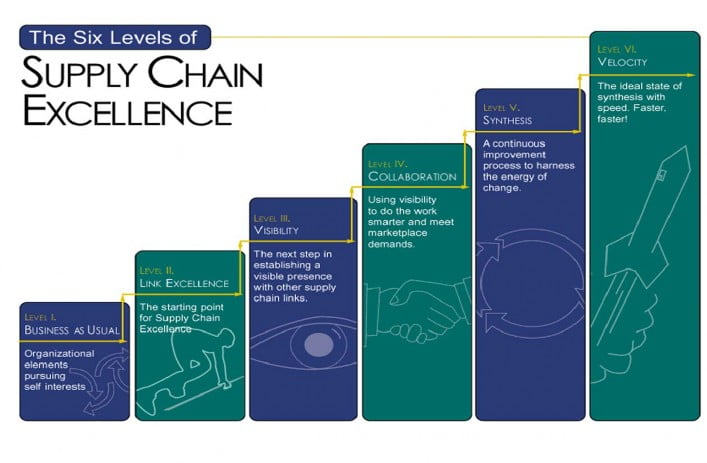
Exhibit 3. Source: Jim Tompkins, 7 Habits of Highly Effective Supply Chains
Companies with high performing global sourcing operations are characterized by the following attributes:
-
Automation to increase the effectiveness of the manual processes still used by many global sourcing operations: This process impacts areas such as offshore vendor quoting and selection, purchase order management, logistics management and customer service.
-
Accurate information to estimate true total delivered costs: This ensures that sourcing decisions consider all factors among different alternatives.
-
Reduction of uncertainty through improved flow across the long global supply chain: This results in reduction of safety stock inventories and leads to expedited costs.
-
Accurate detailed performance measures: These metrics are necessary to look for additional cost savings opportunities, improve negotiating power with global vendors and service providers, and drive continuous improvement in global sourcing operations.
Understanding Total Landed Cost
Total landed cost sourcing takes on a different level of complexity and cost when it comes to managing global supply chains. Typically in a regional sourcing model, logistics costs range from 3% to 5% of total cost. In a global sourcing model involving cross border trade, logistics costs as a percentage of total cost can range from 15% to 35%. At the same time, low-cost country sourcing can deliver 40% or more savings on the piece purchase price. These facts support increased global sourcing, but they also demand effective supply chain strategies to ensure that sourcing benefits are realized.
The Aberdeen Group defines “fully loaded total landed cost” as unit price plus:
-
Average fully loaded transportation costs (including accessories and fuel surcharges)
-
Expediting costs
-
Average handling cost
-
Duties and taxes
-
Documentation and broker fees
-
Financial transaction costs (letter of credit; currency exchange)
-
Inventory carrying costs
-
Inventory obsolescence costs
-
Product rework or damage costs
-
Customer service penalties (charge-backs)
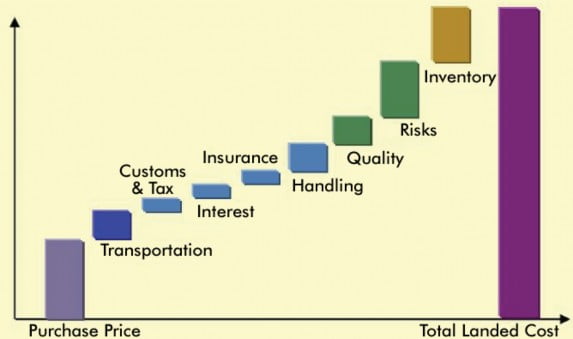
Exhibit 4. Source: i2 Technology
But these are not the only costs in global supply chains. Costs are actually incurred from the start of planning for each product or category and throughout its supply chain execution. Managers who are responsible for the efficiency and effectiveness of global supply chains need performance metrics that are timely, complete, and actionable. Traditional metrics that are transaction- oriented and based on functional or vertical activities may only be concerned with intra-company facilities. They recognize costs in a certain place, at a certain time, and in discrete buckets. A supply chain view crosses multiple departments, divisions or brands, and includes costs throughout the enterprise as well as costs incurred by trading partners and service providers. Moreover, these total costs are recurring.
Total landed costs shown in Exhibit 4 take into account all the cost elements required to land a product originating in one geographic origin to be sold in a different geographic destination. Total delivered cost includes all the cost elements outlined in landed costs, and additionally includes the costs of overhead, capital efficiency, allocations, and other costs that are incurred up to the point of purchase. These costs will vary by country, risk factors, supply chain, transit time and inventory deployment practices.
Keeping store shelves filled requires a responsive supply chain. Supply Chain Excellence will drive continuous cost reductions, increased inventory velocity and on- going compression of cycle time. By their very nature, global supply chains involve multiple parties, long lead times, and continuous flows with variable costs of up to 50 or more distinct cost elements in each supply chain.
Performance metrics must include supply chain objectives and issues such as:
-
Inventory velocity, turns and yield
-
Total landed and delivered costs
-
Cycle times: cash-to-cash, order-to-pay, procure-to-pay, etc.
It is important to identify all global supply chain costs. Costs are incurred along the entire supply chain, end-to-end, starting with planning through execution. The five most critical costs in a global supply chain are:
-
Total landed cost
-
Total delivered cost
-
Working capital
-
Cycle time
-
Costs of customs, taxes and security compliance – regulatory and security compliance
A best practice for identifying global supply chain costs is to “map” each supply chain and develop process models that describe what is taking place in each. Mapping the flows of logistics, information, work, and cash is important for planning and management. In addition, mapping key events, hand-offs, and processing time helps to identify total costs and any opportunities to reduce or control them. These activities should be performed with the help of Logistics Service Providers in order to capture all touch points and costs.
It is clear that global sourcing is an effective strategy that normally reduces overall operating costs. However, as some costs are reduced, others will increase. Global sourcing can add weeks to the supply chain and can tie up as much as 30% of product price in working capital. Improved supply chain financing is facilitated by better knowledge and control of accurate supply information on costs, time and events.
As an example, a $2 Billion retailer with a 68% cost of goods sold ($1.36 Billion) realized a .5% improvement ( $6.8 million) by applying an objective total landed cost calculation that resulted in reduced transportation and expediting costs. This same retailer realized additional improvements in inventory reduction as well as selling, general and administrative expense reduction.
Re-thinking the Supply Chain: Questions to Consider
Managing the total costs of global supply chains involves taking a “network view” to understand all the parties and hand-offs involved. Yet data from the Supply Chain Consortium indicates very little effort in this area. No doubt there are issues of completeness. Most members indicate that global supply chains involve: higher costs and complexities of transportation; longer lead times; extended use of working capital; customs, duties and taxes; and other costs of moving and storing goods and inventories. There are also additional indirect costs to consider.
Global supply chains are complex, with end-to-end points crossing international boundaries causing more uncertainties. There are also more parties involved with global supply chains, often leading to higher variability and volatility. There are inherently more risks involved, such as weather delays, acts of terrorism, theft, counterfeiting, labor actions, and others. The complexity of global supply chains requires intense management focus and improved scenario planning for cost stabilization and/or improvement while maintaining or improving customer service.
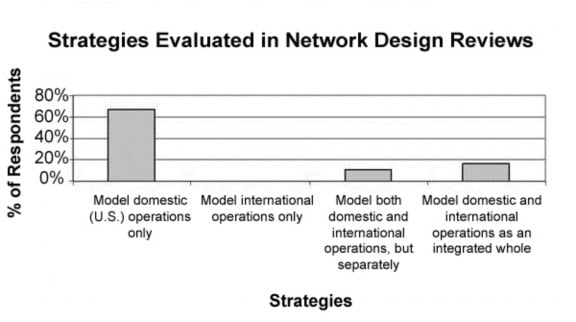
Exhibit 5. Source: The Supply Chain Consortium
Logistics may be the largest cost component of the global supply chain, yet as shown above, few companies model the supply chain in an integrated or comprehensive manner. Fortunately, there are methods and tools that can help address these costs and at the same time aid in supply chain performance. It is imperative, however, to consider some new ways of thinking about global supply chains in order to achieve transformational change, or even to identify key opportunities that require cross-functional cooperation to evolve. Some questions to gauge a company’s readiness to address these more complex supply chain challenges are:
-
Does your company agree with the view that ultimate success is all about the supply chain – how it’s designed, organized and managed?
-
Does your company believe that total delivered cost is the most important factor in product pricing and thus in operating models?
-
Is your company willing to find innovative ways to plan, buy/source, move, and store and sell goods and products; to transform business process and to change people?
-
Is your company willing to look at the impact of total logistics costs on sourcing decisions in order to achieve speed-to-market at the lowest delivered cost?
-
Is your company willing to look more broadly at logistics costs, especially transportation, in order to optimize freight spend synchronized with sourcing decisions and speed-to-market priorities?
By considering these questions, companies can uncover new opportunities to drive performance. Jointly agreeing on priorities, creating a roadmap and committing funding and resources based on ROI will drive alignment of goals and objectives across functional groups. This is the only way to positively impact revenue growth, profit margins and ultimately, shareholder value on a sustainable basis.
Decision Support: Analytical-based Methods and Tools
Re-thinking global supply chains – and driving toward total delivered cost in today’s complex world – requires new and improved decision support methods and tools. Fortunately, these tools do exist and are beginning to make a difference in retail supply chains from plans to point of sale.
A shared characteristic among leading retail and consumer product goods companies is their focus on enterprise-wide planning and monitoring. Technology has rapidly evolved to better enable this advantage even as increased globalization has added complexity. Decision support systems (DSS) represent one important class of tools used for this purpose.
Logistics organizations originally adopted these tools to analyze the effectiveness of their infrastructure network – DCs, cross-docks, manufacturing and supply sources, customer delivery locations, etc. The issues generally analyzed include:
-
How well does the network support service and costs requirements?
-
What are the right performance metrics?
-
Where bottlenecks currently exist and are likely to arise in future demand/service scenarios?
-
What impact do transport modes and practices have on a network?
-
How do inventory policies impact network performance (cost and service)?
-
What strategies should be employed in order to mitigate supply chain disruptions from a logistics perspective?
These issues and their solutions continue to be relevant in today’s world, but the difficulty comes when companies attempt to represent a complete supply chain view. Capturing sufficient information about all relevant entities of each partner in the supply chain is one challenge. Yet, most companies are hard pressed to do this internally. Therein lies a key differentiator for the leading companies: Cross-enterprise processes and collaborations enable them to develop enterprise-wide models that are then analyzed using DSS.
Today, DSS tools are used to evaluate, design, and optimize entire supply chains – from planning to selling. Retailers and CPG companies are beginning to employ these tools to support decisions on many levels. For example:
Total delivered costs: This analysis starts with the sourcing decision. Total delivered cost support models help evaluate the total impacts on freight costs, customs and taxes, working capital, the value of time, and risks of supply chain disruptions. At the same time, piece costs, re-work, and even indirect costs such as management time are factored into the picture. Then, once the best sourcing locations are selected, few are willing to leave the transport decisions to the selected suppliers’ discretion. Instead, they are correctly opting to pre-define the routing from off-shore suppliers to points of delivery. Costs associated with the port of entry are often under-estimated. Port delays, congestion, throughput, and inland transport to point of delivery all add up and increase costs.
The complexities and costs of routing are further compounded by inventory policies and decisions which dictate shipment sizes and mode. Sophisticated models account for all of these factors, allowing retailers to evaluate these decisions on a regular basis. Moreover, as game-changing events occur (high volatility in fuel prices, spikes in labor and overhead rates of low cost country sources, compliance and regulatory adjustments, and demand swings), re-evaluating decisions can be done earlier and changes implemented quicker when a model is in place.
Optimize freight spend: Transportation is central to supply chain efficiency; as a result, logistics costs are often the highest cost drivers. To better manage these costs, leading retailers are diligent in analyzing total freight moves holistically, instead of minimizing transport costs lane by lane. In other words, many realize the value in finding consolidation opportunities to lower total freight costs across the supply chain instead of sub-optimizing by planning for inbound moves separate from intra-facility and outbound. More advanced supply chain managers are extending the optimization to include the freight of partners as well. The results have been surprising and often challenge traditional thinking on end-to-end moves – from sourcing to carrier management to store receiving policies.
Merchandising optimization: This objective is especially powerful in minimizing in-store losses, out of stocks, and inventory holdings. Applications exist to assist with store level mark-down optimization, item level replenishment, promotions, store level pricing, product substitution strategies, inventory positioning and re- positioning, and returns management, just to name a few. Software-as-a-service tools such as TrueDemand even support in-store location decisions and shelf stocks. These decisions not only impact how well inventory moves off the shelf, but they can also have a major impact on total supply chain and business costs and revenues.
These types of applications are available from a variety of technology suppliers. Providers such as i2 Technology, Red Praire, Manhattan Associates, JDA, Logility, Oracle, and SAP have invested significantly in addressing the supply chain challenges of retailers. i2, for example, provides the supporting tools as well as supports partner collaborations for total supply chain planning and execution. Their powerful Inventory Optimizer, for instance, includes the capability to involve service providers and carrier actions into the model.
Global supply chain risk management is another area of concern to retailers and CPG companies. The advanced decision support tools enable managers to assess factors such as: demand risks; sourcing changes; labor actions; capacity constraints; economic downturns; scenario forecasts; and other potential disruptions. Quantifying and mitigating risks is critical in today’s volatile economy.
It should be noted, however, that companies such as The Limited, Sears, and Wal- Mart can attest that these tools certainly provide support but are not the primary success factor. Results can also be achieved by leveraging rudimentary data analysis. The insight gained sets the foundation for thinking about your business differently – seeing it as truly a set of supply chains. Investments in tools must accompany investments in human talent to carry out this important process of supply chain analysis. More importantly, the organization must be ready and willing to align the various internal functions and external partners to develop and employ models that depict the supply chains accurately and holistically. From that basis, powerful results can be achieved in growing and sustaining business growth.
One last point must be considered when initiating the investment and application of advanced decision support models. The best tools, in the hands of talented users, have to be accepted into the company’s decision-making processes. We have seen good companies relegate these resources to a “planning office” not integrated into the decision- making process. This is a mistake. Senior management must commit to support the development of these tools, and then influence their use. Further, because the advanced models address the complete process – from planning to sourcing to moving and to selling – all departments of the retailer must work in tandem to build and make use of their results. Buying based on one set of criteria, and supplying stores based on another, will not optimize the business value overall.
EyeForTransport’s 2008-2009 survey on supply chain technology reveals that most companies expect to continue their investments even in the face of slowing growth. This is a further testament to the complexity of supply chain planning and execution, and to the importance of managing supply chain costs. As seen in Exhibit 6, the top reason for enhancing or upgrading supply chain technology is to improve operational efficiency.
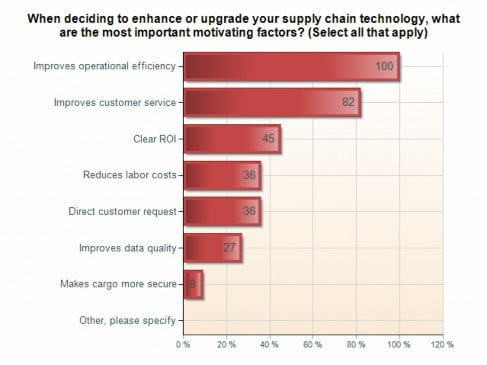
Exhibit 6. Source: EyeForTransport
Translating Re-thinking into Improved Performance
Supply chain transformation can and should involve re-thinking the global supply chain, re-thinking the organization models, re-evaluating tools and methods, re-engaging with service providers, and implementing new technologies. It may well require a multi- year time frame to achieve all the benefits; however, the best approaches can be done on a “pay-as-you-go” basis, where incremental cost savings and sales growth provide the capital for the subsequent changes. Yet there are examples in which this strategy has been poorly executed or failed entirely. It is very important to plan and execute a transformation with the right knowledge and experience at the base.
In today’s economy, it is especially critical to identify priorities that impact operational performance in the near term, while planning effectively for the future. To ensure development of the most effective solutions for sourcing through to selling, consider the path to success provided in Exhibit 7:
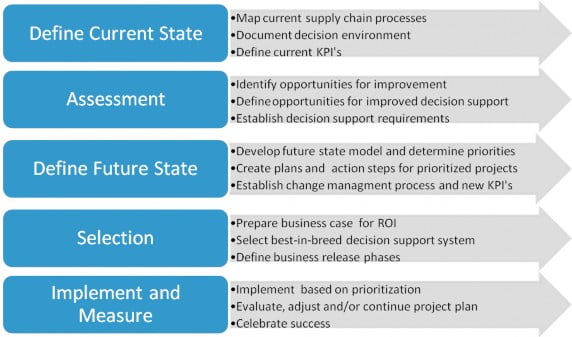
Exhibit 7. Path to Success
Oftentimes, companies believe they have obtained all the “low hanging fruit” and will delay taking further action while they evaluate and plan for a major transformation. This is typical when looking for opportunities only within a function, vs. across multiple functions, processes, brands or business units. Getting past this requires executive commitment and sponsorship to help leaders see beyond targets which may have worked well in the past, but are not sufficient in today’s world to achieve the Supply Chain Excellence necessary for sustainable performance. It is important to maintain objectivity and the ability to look at the current process with fresh eyes in order to drive re-thinking into action that leads to improved performance.
Summary
The topics covered in this paper are intended to challenge current thinking and to assist in identifying key opportunities to improve global supply chain performance. In the old days of retail, success had a more obvious path. But with today’s constant winds of change, the moving target of customer preference, the distance involved with a global shot heard around the world and the unbelievable speed of the marketplace, decision support systems are critical. Otherwise, you risk not achieving success.
More than ever before, actions to improve performance and gain efficiencies in global supply chains should emerge from re-thinking strategies and business models, not from across the board cuts that can prohibit innovation. Re-thinking is the best practice of retailers who intend to survive and thrive in 2009 and beyond. Significant opportunities remain in global supply chains for optimizing costs and contributing to profitable growth. Business leaders who understand the importance of competing on comprehensive global supply chain performance and who commit to its operational excellence will be the winners of the future.
As the vice chairman of Limited Brands – Len Schlesinger – stated publicly a year or so ago, “So, you do not understand the importance of supply chains to your business? I would love to compete with you!” Knowing what to do with supply chains, and how to do it, should be on all retail executive agendas.
About the Author
Valerie Bonebrake is Senior Vice President, Global Supply Chain Services, for Tompkins Associates. With more than 25 years of industry experience in third- party logistics, Valerie has a proven track record in developing, implementing and operating logistics services in North America and globally. She has worked with a broad array of companies and industries including retail, consumer products, paper, food distribution, high tech, manufacturing and wholesale distribution. Her commitment to developing effective strategies, coupled with practical and efficient delivery of solid business solutions, has resulted in profitable growth, efficient operating platforms and customer satisfaction for her clients.
About Tompkins Associates
Tompkins Associates designs and integrates global end-to-end solutions for companies that embrace supply chain excellence. For more than 30 years, Tompkins has evolved with the marketplace to become the leading provider of global supply chain services, distribution operations consulting, technology implementation, material handling integration, and benchmarking and best practices. The company is headquartered in Raleigh, NC. For more information, visit www.tompkinsinc.com.
Innovative, practical solutions that improve your supply chain performance and produce value-based results
References
-
Institute of Management Accountants, Managing the Total Costs of Global Supply Chains, 2008
-
EyeForTransport, Logistics Technology Report: North America, 2008
-
CSCMP Supply Chain Quarterly, The Case for Profitable Proximity, Quarter 3, 2008
-
The Seven Habits of a Highly Successful Supply Chain, Jim Tompkins, 2006 5, The Supply Chain Consortium, 2008
The Supply Chain Consortium offers a number of resources to achieve world-class supply chain excellence. In developing any strategy, one-on-one networking with other supply chain executives can be invaluable. Knowledgeable peers can be found through the PeerNet resource on the Resource Center page at www.SupplyChainConsortium.com.
Contact Information:
Valerie Bonebrake Tompkins Associates
vbonebrake@tompkinsinc.com
Tompkins Associates
6870 Perry Creek Road Raleigh, NC 27616
www.tompkinsinc.com
United States Canada Europe Asia


